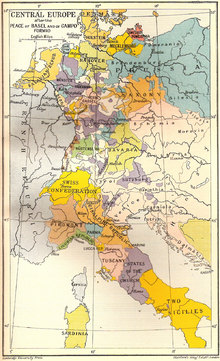Peace of Campo Formio

The Peace of Campoformio was concluded on October 17, 1797 between France , represented by Napoléon Bonaparte , and Emperor Franz II in his capacity as ruler of the Habsburg hereditary lands (due to the pragmatic sanction , especially as King of Hungary and Bohemia and Archduke of Austria ) . The peace ended the First Coalition War begun by France on April 20, 1792 .
designation
The name Campoformio does not designate a place, but a field (Italian: campo ) west of Udines in what is today the Friuli-Venezia Giulia region in northern Italy , where there is also a place called Campoformido . The peace treaty was not signed either on the Campoformio or in Campoformido - the camp of the Austrian army was there. Rather, the Austrian Army Command had to go to Napoléon's headquarters: to Villa Manin , about 25 km west of Udine. There Napoleon made the Austrians wait late into the night before appearing to sign.
The name "Campo Formio" itself goes back to a typo from a French pen.
Pre-peace of Leoben
The Peace of Campoformio was preceded by the preliminary peace of Leoben , a provisional agreement aimed at ending hostilities between the two great powers and preparing for a final peace. The preliminary peace of Leoben was signed on April 18, 1797 by General Napoleon Bonaparte and the Austrian General Merveldt. The agreement itself was only approved by the governments of France and Austria on May 4 and May 14, 1797 and ratified on May 24, 1797.
Content of the Peace of Campoformio
The treaty determined the emperor's renunciation of the Austrian Netherlands in favor of France and brought about a reorganization of Northern Italy and the possessions of the Republic of Venice . The emperor recognized the independence of the Cisalpine Republic and in return received the territory of the former Republic of Venice and its possessions up to the Adige River , as well as Istria , Dalmatia and the Bay of Kotor . This also included the large Venetian navy , which in the following decades formed the heart of the still young Austrian navy . France kept Lombardy and the Ionian islands of Corfu , Zakynthos and Kefalonia . It was now at peace in continental Europe for the first time since 1792, while the war with Britain continued.
consequences
The secret amendments to the treaty signed by Napoleon Bonaparte and Austrian ambassadors were particularly significant for German history . Emperor Franz II recognized in Article 1 the Rhine between Basel and the river Nette south of Andernach as the eastern border of France (“… La rive gauche du Rhin depuis la frontière de la Suisse au dessous de Basle jusqu'au confluent de la Nette au dessus d'Andernach ... “).
The final arrangements with the Holy Roman Empire of the German Nation were reserved for the Rastatt Congress (December 9, 1797 to April 23, 1799), which however was never brought to an end due to the outbreak of the Second Coalition War .
See also
Web links
- The original text of the contract in French, but without the secret additional articles
- English-language contract excerpt with secret additional articles
- German translation of the French contract text - incl. secret article - pdf
- Secret additional articles, original text in French and German, reprint from 1797
Individual evidence
- ^ Adam Zamoyski: Napoleon 'One Life. Beck, Munich 2018, pp. 207f.
- ^ Günter Jontes: The preliminary peace of Leoben and the events of the first French invasion of Styria. Upper Styrian Cultural Association, Leoben 1997.
- ^ Paul Fabianek: Consequences of secularization for the monasteries in the Rhineland - Using the example of the monasteries Schwarzenbroich and Kornelimünster. Verlag BoD, 2012, ISBN 978-3-8482-1795-3 , p. 7 and 8 with image of the signatures and seals
